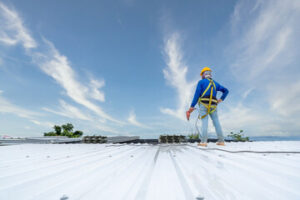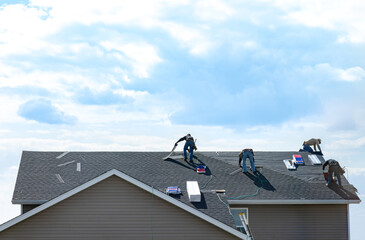The roof of a commercial property protects employees, inventory, and customers. So, it must stand up to the elements and last.
Choosing the right roofing material is an important decision. Depending on your building and its durability needs, here are 5 options. You should also consider your budget and maintenance requirements. Talk to 5R Roofing professionals to get started.
 Shingles
Shingles
Shingles are a popular choice for residential roofs, but they can also be an excellent roofing option for commercial buildings. They provide durable protection for your business and can be customized to match the design and aesthetic of your building. They are also typically less expensive than other types of commercial roofs, making them a viable option for businesses on a budget.
Commercial shingles can be made of several different materials, with asphalt shingles being the most common choice. They are available in a variety of colors and styles, with some even having a reflective coating to help reduce energy costs. When it comes to choosing a commercial shingle for your building, you want to make sure that you choose one that is high-quality and will last as long as possible.
Be sure to avoid builder-grade shingles, as they are not designed for the increased wind pressure that a commercial building may experience. You can upgrade to architectural or designer shingles, which offer greater wind protection and are backed by longer warranties. Other options for commercial shingles include cedar, which is resistant to rot and can be stained to look like a more natural wood color. However, this type of roof is not ideal if you will be venting grease, fats, oils, or other flammable substances at the roof level. Instead, opt for a more fire-resistant roofing material such as PVC.
Metal
Metal commercial roofing offers many benefits over other types of roofs. It can last for decades, doesn’t require much maintenance, and can withstand extreme weather conditions, such as hail or hurricane-force winds. Metal roofs are also fire-resistant and energy-efficient. They reflect sunlight which lowers cooling costs during the summer and insulate better than shingle roofs, resulting in lower energy bills during winter.
Metal is a versatile roofing material that’s available in many different styles and finishes. Depending on your design preferences, you can choose the panel substrate (steel, aluminum, or copper), the panel thickness and color, and accessories that can give it a custom appearance. You can also find products that mimic the look of shingles, clay tiles, or asphalt shingle roofs without the costly up-front cost.
There are two main types of commercial metal roofs: Exposed fastener and Standing seam. Exposed fastener metal roofs use overlapping panels that are secured to the building’s deck using exposed fasteners. They have a more industrial aesthetic and can be used on a variety of building types. Standing seam metal roofs, on the other hand, are designed to create a sleek, modern architectural aesthetic and are commonly found in schools, office buildings, and recreational facilities. Standing seam metal roofs are a popular choice in hurricane-prone areas because of their exceptional durability and wind resistance. They have a three-hour fire rating and are an ideal roofing option for high-rise buildings or those with climate control requirements.
Single-Ply
Single-ply membrane roofing provides a durable and cost-effective alternative to traditional built-up roof systems. This membrane is installed in a single layer, making installation quicker and easier. It also requires fewer specialized tools and professional contractors, which reduces labor costs. Additionally, it’s a more energy-efficient choice, as it’s reflective and allows natural light to pass through the translucent material.
Thermoset single-ply membranes such as EPDM (ethylene propylene diene monomer) and TPO (thermoplastic polyolefin) are strong, flexible, and chemically resistant. They are popular for commercial roofing due to their high durability, low maintenance costs, and energy efficiency.
Unlike shingles, single-ply membranes can be mechanically or fully adhered to the roof. They are also lightweight, providing a quick and easy installation process. They also provide excellent protection against harsh weather conditions and a long lifespan.
These single-ply membranes have the added benefit of being easily reversible, allowing for simple repairs and modifications. However, like other types of roofing materials, the seams on these membranes can be subject to stress and damage. If this occurs, it’s important to have a skilled contractor perform repairs and re-seam the membrane.
Some of the most common issues with these membranes are the development of brittleness, shrinking, and loss of elasticity. Other problems include poor installation or uncontrolled expansion, which can cause the membrane to rip and tear. However, with the help of a trusted commercial roofing company, you can minimize these problems and keep your commercial roof looking its best.
Built-Up
Built-up roofing, or BUR, is a popular option for flat and low-sloped commercial roofs. Typically, it has a thick base of insulation and a cover board that is then covered with alternating layers of bitumen and ply sheets, such as roof felt. The bitumen can be “cold,” or bonded with adhesives, or “hot,” which is applied with a torch. The final layer is often aggregate, which is stone or gravel. These layers provide a sturdy, waterproof surface that can withstand heavy foot traffic and weather conditions.
The layered nature of this type of roof provides redundancy that is not found in other types of commercial roofing. The many layers also act as an effective insulation system for a building, and they help to reduce energy costs. Depending on the materials used, a BUR roof may be eligible for a guarantee or warranty of up to 20 years.
The most important benefit of a BUR is its durability. This roof type is highly resistant to damage from wind and fire, and it has a high fire rating. Its durable construction is a major reason why it is one of the most commonly used types of commercial roofs. It also has a lower water absorption rate than other roof types, which helps to protect the interior of a structure from leaks. This is particularly useful for buildings in warm climates. A BUR roof can also be made more reflective, which will further reduce energy costs and cooling needs.
Modified Bitumen
Modified bitumen, or “Modbit,” is a tried-and-true flat commercial roofing material. It is extremely durable and offers several benefits that make it an ideal choice for any flat roof.
It is highly resistant to tearing. Its reinforcing layers protect it from the wind, hail, and other natural elements that can wreak havoc on a low-slope commercial roof. Modbit also stands up to harsh weather conditions like high heat and UV rays. Its UV protection helps reduce energy costs by reflecting the sun’s rays away from the building.
Another advantage of this roofing material is that it’s easy to install and repair. Modbit can be applied with either the BUR method, cold adhesives, or self-adhering sheets. This allows for a seamless connection between the roofing sheets, preventing cracks and leaks.
Modbit comes in many different colors and styles, giving the building owner options for aesthetic appeal. Some are more reflective, while others are designed for durability and longevity. It is also fire-resistant and can reduce insurance premiums because of this quality.
The one disadvantage of modified bitumen is that it needs the help of a skilled roofer. A typical MB roof requires the use of a blow torch with extreme heat to adhere to the membranes. This can lead to a fire hazard, so it’s essential to choose a qualified roofer. This method also produces harmful fumes that can be dangerous to people in the building.
Spray Polyurethane Foam
Spray polyurethane foam (SPF) is an insulation product that is sprayed as a liquid onto the existing roof and expands into a solid layer. This provides thermal, air, and moisture protection. It also provides an airtight seal and reduces the potential of leaking. SPF can be applied to a variety of surfaces including metal roofs, concrete slabs, and wall cavities.
The insulating value of SPF is measured by its R-value. This means that it can be used in buildings that need to conserve energy and reduce heating or cooling costs. The total payback of an SPF roof typically occurs within ten years through savings in energy bills alone.
SPF roofing is durable and can last the lifetime of your facility. However, it is important to perform regular inspections of your roof to ensure that it remains in good condition. If you notice any signs of damage, it is important to take immediate action. This can include moving equipment and furniture to avoid water damage, covering items that cannot be moved, and marking leak areas to show a professional.
Before applying any roofing materials, you must ensure that the surface is clean and dry. Then, a layer of tar paper or waterproofing material should be laid on the roof to prevent any further damage. Once the tar paper has been placed, it is a good idea to cover it with a spray coat of urethane or silicone.


